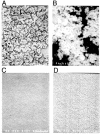Lysostaphin disrupts Staphylococcus aureus and Staphylococcus epidermidis biofilms on artificial surfaces
- PMID: 14576095
- PMCID: PMC253758
- DOI: 10.1128/AAC.47.11.3407-3414.2003
Lysostaphin disrupts Staphylococcus aureus and Staphylococcus epidermidis biofilms on artificial surfaces
Abstract
Staphylococci often form biofilms, sessile communities of microcolonies encased in an extracellular matrix that adhere to biomedical implants or damaged tissue. Infections associated with biofilms are difficult to treat, and it is estimated that sessile bacteria in biofilms are 1,000 to 1,500 times more resistant to antibiotics than their planktonic counterparts. This antibiotic resistance of biofilms often leads to the failure of conventional antibiotic therapy and necessitates the removal of infected devices. Lysostaphin is a glycylglycine endopeptidase which specifically cleaves the pentaglycine cross bridges found in the staphylococcal peptidoglycan. Lysostaphin kills Staphylococcus aureus within minutes (MIC at which 90% of the strains are inhibited [MIC(90)], 0.001 to 0.064 microg/ml) and is also effective against Staphylococcus epidermidis at higher concentrations (MIC(90), 12.5 to 64 microg/ml). The activity of lysostaphin against staphylococci present in biofilms compared to those of other antibiotics was, however, never explored. Surprisingly, lysostaphin not only killed S. aureus in biofilms but also disrupted the extracellular matrix of S. aureus biofilms in vitro on plastic and glass surfaces at concentrations as low as 1 microg/ml. Scanning electron microscopy confirmed that lysostaphin eradicated both the sessile cells and the extracellular matrix of the biofilm. This disruption of S. aureus biofilms was specific for lysostaphin-sensitive S. aureus, as biofilms of lysostaphin-resistant S. aureus were not affected. High concentrations of oxacillin (400 microg/ml), vancomycin (800 microg/ml), and clindamycin (800 microg/ml) had no effect on the established S. aureus biofilms in this system, even after 24 h. Higher concentrations of lysostaphin also disrupted S. epidermidis biofilms.
Figures






Similar articles
-
Staphylococcus aureus biofilm as a target for single or repeated doses of oxacillin, vancomycin, linezolid and/or lysostaphin.Folia Microbiol (Praha). 2006;51(5):381-6. doi: 10.1007/BF02931580. Folia Microbiol (Praha). 2006. PMID: 17176756
-
Combinations of lysostaphin with beta-lactams are synergistic against oxacillin-resistant Staphylococcus epidermidis.Antimicrob Agents Chemother. 2002 Jun;46(6):2017-20. doi: 10.1128/AAC.46.6.2017-2020.2002. Antimicrob Agents Chemother. 2002. PMID: 12019130 Free PMC article.
-
Lysostaphin as a potential therapeutic agent for staphylococcal biofilm eradication.Pol J Microbiol. 2005;54(3):191-200. Pol J Microbiol. 2005. PMID: 16450834
-
Lysostaphin: an antistaphylococcal agent.Appl Microbiol Biotechnol. 2008 Sep;80(4):555-61. doi: 10.1007/s00253-008-1579-y. Epub 2008 Jul 8. Appl Microbiol Biotechnol. 2008. PMID: 18607587 Review.
-
Lysostaphin: Engineering and Potentiation toward Better Applications.J Agric Food Chem. 2022 Sep 21;70(37):11441-11457. doi: 10.1021/acs.jafc.2c03459. Epub 2022 Sep 9. J Agric Food Chem. 2022. PMID: 36082619 Review.
Cited by
-
Staphylococcal Biofilm Development: Structure, Regulation, and Treatment Strategies.Microbiol Mol Biol Rev. 2020 Aug 12;84(3):e00026-19. doi: 10.1128/MMBR.00026-19. Print 2020 Aug 19. Microbiol Mol Biol Rev. 2020. PMID: 32792334 Free PMC article. Review.
-
Recent Advances in Multifunctional Hydrogels for the Treatment of Osteomyelitis.Front Bioeng Biotechnol. 2022 Apr 25;10:865250. doi: 10.3389/fbioe.2022.865250. eCollection 2022. Front Bioeng Biotechnol. 2022. PMID: 35547176 Free PMC article. Review.
-
Engineered device in E. coli lyses S. aureus at physiological fever temperatures.MicroPubl Biol. 2022 Aug 1;2022:10.17912/micropub.biology.000616. doi: 10.17912/micropub.biology.000616. eCollection 2022. MicroPubl Biol. 2022. PMID: 35983013 Free PMC article.
-
Recombinant Expression of a Putative Amidase Cloned from the Genome of Listeria monocytogenes that Lyses the Bacterium and its Monolayer in Conjunction with a Protease.Probiotics Antimicrob Proteins. 2012 Mar;4(1):1-10. doi: 10.1007/s12602-011-9084-5. Probiotics Antimicrob Proteins. 2012. PMID: 26781731
-
Development of a Novel Chimeric Endolysin, Lys109 With Enhanced Lytic Activity Against Staphylococcus aureus.Front Microbiol. 2021 Jan 15;11:615887. doi: 10.3389/fmicb.2020.615887. eCollection 2020. Front Microbiol. 2021. PMID: 33519773 Free PMC article.
References
-
- Amorena, B., E. Gracia, M. Monzón, J. Leiva, C. Oteiza, M. Pérez, J. Alabart, and J. Hernández-Yago. 1999. Antibiotic susceptibility assay for Staphylococcus aureus in biofilms developed in vitro. J. Antimicrob. Chemother. 44:43-55. - PubMed
-
- Bellón, J. M., N. G-Honduvilla, F. Jurado, A. G-Carranza, and J. Buján. 2001. In vitro interaction of bacteria with polypropylene/ePTFE prostheses. Biomaterials 22:2021-2024. - PubMed
-
- Browder, H., W. Zygmunt, J. Young, and P. Travormina. 1965. Lysostaphin: enzymatic mode of action. Biochem. Biophys. Res. Commun. 19:383-389. - PubMed
-
- Centers for Disease Control and Prevention. 1998. Preventing emerging infectious diseases: a strategy for the 21st century. Centers for Disease Control and Prevention, Atlanta, Ga.
-
- Chamis, A., G. Peterson, C. Cabell, G. Corey, G. Sorrentino, R. Greenfield, R. Thomas, L. Reller, and V. Fowler. 2001. Staphylococcus aureus bacteremia in patients with permanent pacemakers or implantable cardioverter-defibrillators. Circulation 104:1029-1033. - PubMed
MeSH terms
Substances
LinkOut - more resources
Full Text Sources
Other Literature Sources
Medical
Molecular Biology Databases

